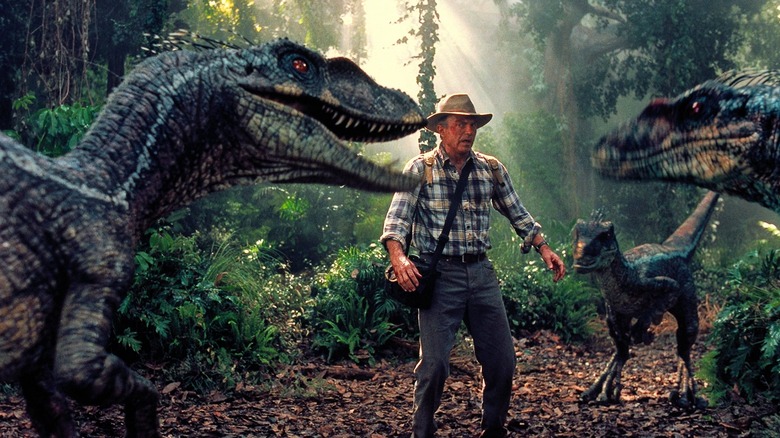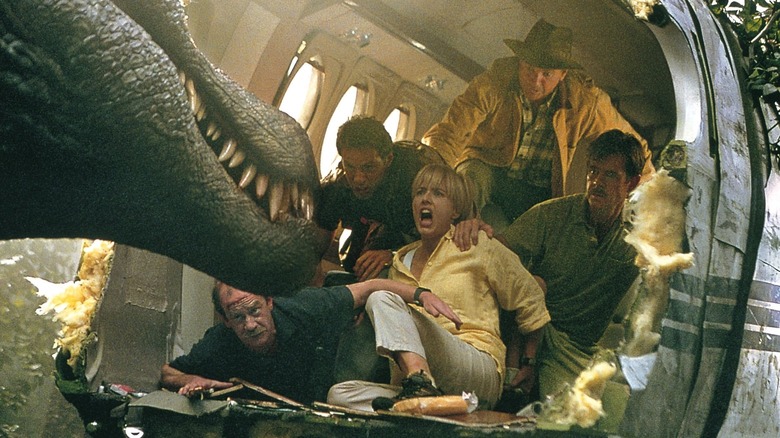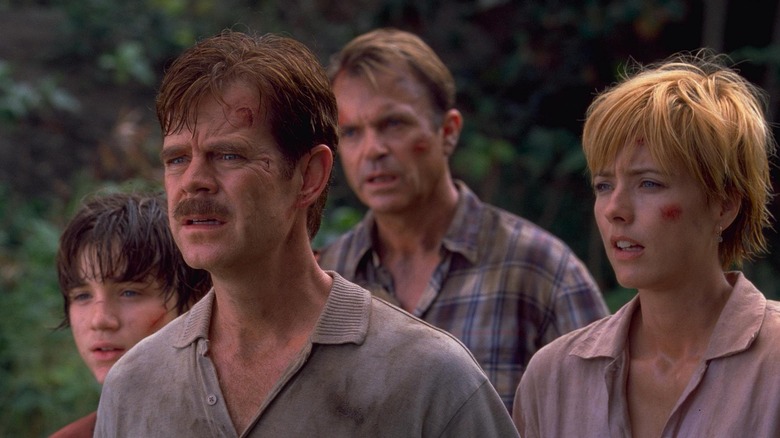The Fake Dinosaurs Of Jurassic Park III Could Actually Kill You
The original "Jurassic Park" film by Steven Spielberg made history through its outstanding achievements in animatronics and complex puppetry, truly bringing dinosaurs to life through pure blockbuster magic. It is a movie that provided modern culture with the image of what a dinosaur looks like, and how it moves and behaves.
While there's been no shortage of animatronic dinosaurs since then, the franchise has struggled with the hunger for innovation and the desire to escalate what the original film achieved. Should these films lean into the horror of these dinosaurs, or should they embrace the fast-paced action spectacle of the franchise?
Joe Johnston's approach to "Jurassic Park III" was certainly interested in the latter, and with a bigger vision demanded bigger technology to follow it. Coupled with the production issues that led Johnston to describe the set experience as "a living hell on a daily basis," the physical danger of the animatronics used on the third film may have informed the franchise's more extensive use of computer generated VFX as the newer movies continued to focus on an action-oriented tone.
Bigger vision, bigger technology
In a behind the scenes feature for "Jurassic Park III," actor Michael Jeter, who played the mercenary pilot Udesky, revealed that Stan Winston once sincerely warned him on one of his first days on set that these fake dinosaurs could still kill him. Winston was the live-action dinosaur technician on all three original "Jurassic Park" films, and stressed that while these puppets didn't have a mind of their own, they were still big, strong, and nearly as destructive as the real thing.
Going over the process for one of the film's biggest set-pieces, the fight between the Spinosaurus and T-rex, Winston admitted that the scene was so complex that something was bound to be broken in the process of shooting, so they took a T-rex animatronic from "Jurassic Park: The Lost World" and let it rumble against the Spinosaurus animatronic, as both were planned to be scrapped after production. The Spinosaurus animatronic turned out to be so powerful, it actually ripped off the head of the T-rex while they were filming their battle, a sight described to be just as violent on the soundstage as it was on film.
Winston continued to describe the strength of the Spinosaurus animatronic when referencing the lake scene, revealing that the hydraulics of the animatronic had 1,000 horsepower behind it. He claims this specific scene as one of those most realistic experiences he's ever had working with an animatronic, as the Spinosaurus dived into the water to interact with the actors, the rain, and the fire, truly giving the feeling that it was an "alive" animal.
There's a soul behind these puppets
Stan Winston's enthusiasm and awe at these puppets, even after supervising three films with them, shows that they can continually surprise even the most experienced specialists. But to wield these puppets responsibly, that awe must also be tempered by caution and instinct. In a response fitting for his wise character of Alan Grant, Sam Neill admitted in another behind the scenes featurette that he tried to avoid thinking of these puppets as mindless and instead viewed them as their own sentient beings, living and breathing with the intelligence of the 12 people it takes to operate one of them.
The "Jurassic World" trilogy took an even more bombastic, action-oriented tone than its predecessors, allowing much more screen time for dinosaurs across those three films. No, the filmmakers didn't build a giant Indominus Rex to go against the Mosasaurus or send raptors to chase Chris Pratt on his motorcycle, especially with the risks demonstrated on the set of "Jurassic Park III." But director Colin Trevorrow still remembered the importance of showing little moments of physicality whenever possible, like the Apatosaurus moment with Claire and Owen, or the various moving pieces of the dino black market scene in the latest entry, "Jurassic World Dominion." While these films often fail to capture the magic of the original, it's comforting to at least know the effort was made to try.


